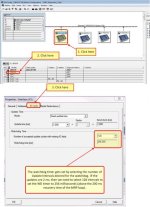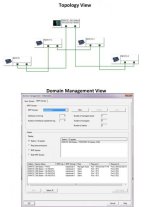Mark Whitt
Member
Hello fellow Automation folks!
Disclosure: I've made this same post on the Siemens support forum, but so far haven't gotten anywhere. So, I'm hoping that someone here may be able to lend some guidance.
I'm new to MRP and having some trouble understanding some things about it.
I've read where it should take on the order of 200 milliseconds for an MRP loop to detect a break and re-route messages the other way around the loop. But when I test the setup I have here, it seems to take about 5 seconds for the bus to recover and data to start coming into the PLC again.
I wondering if I have something configured wrong?
Here's a link to a picture of the Topology and the Domain Management views of the configuration that I'm using: ftp://ftp-static.mt.com/pub/Indmkg/Whitt/Temp/MRP.jpg
I'm using an S7-315 2 PN/DP for my tests. I have the MRP loop connected to both Ethernet ports, and am monitoring the program data over the USB MPI link. Programming package is Step 7 V5.5 SP3.
The details of what I'm seeing are:
Oh! And the devices on the network are new. It's possible that there is a problem with the devices themselves.
Thanks in advance for any comments and guidance!
Disclosure: I've made this same post on the Siemens support forum, but so far haven't gotten anywhere. So, I'm hoping that someone here may be able to lend some guidance.
I'm new to MRP and having some trouble understanding some things about it.
I've read where it should take on the order of 200 milliseconds for an MRP loop to detect a break and re-route messages the other way around the loop. But when I test the setup I have here, it seems to take about 5 seconds for the bus to recover and data to start coming into the PLC again.
I wondering if I have something configured wrong?
Here's a link to a picture of the Topology and the Domain Management views of the configuration that I'm using: ftp://ftp-static.mt.com/pub/Indmkg/Whitt/Temp/MRP.jpg
I'm using an S7-315 2 PN/DP for my tests. I have the MRP loop connected to both Ethernet ports, and am monitoring the program data over the USB MPI link. Programming package is Step 7 V5.5 SP3.
The details of what I'm seeing are:
- When I break the loop in one direction, the interrupt is almost unnoticeable. However, when I re-connect the break, the devices will drop offline for about 5 seconds. Is this normal?
- When I break the loop in the other direction, the devices drop offline for about 5 seconds. When I reconnect the break, the devices drop offline again for another 5 seconds. This one surprised me the most.
- When the communications drop out, the SF and BF2 lights will flash on the PLC. When the communications re-establish, the lights go out. This all seems to line up with what I'm seeing happening to the data as the links re-establish.
Oh! And the devices on the network are new. It's possible that there is a problem with the devices themselves.
Thanks in advance for any comments and guidance!




